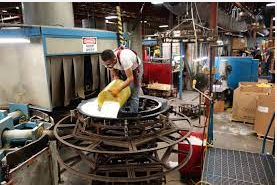
Rotomolding: Where Art Meets Engineering
Rotational molding or Rotomolding is really a method utilized to create hollow plastic material products. One of many crucial sides of Plastics Rotomolding is deciding on a materials. The material assortment method is critical to final product or service good quality, because it influences the energy, durability, potential to deal with wear, and overall appearance from the product. This post will discover the several types of Rotomolding resources, their advantages, disadvantages, and considerations for deciding on the best supplies for the project.
Polyethylene (PE)
Polyethylene is essentially the most commonly used Rotomolding fabric. It is available in different kinds, including lower-solidity polyethylene (LDPE), linear very low-solidity polyethylene (LLDPE), and moderate-solidity polyethylene (MDPE). The main advantage of polyethylene is its durability and flexibility, rendering it an adaptable materials. It is additionally light-weight, simple to mildew, and possesses a very high effectiveness against chemical compounds and weather. Its primary disadvantage is that it will not be suited to substantial-temperatures applications.
Nylon (PA)
Nylon can be another preferred materials for Rotomolding programs. It is solid, durable, and it has a higher effectiveness against abrasion, damage, and puncture. In addition, it has very good compound and also heat level of resistance components, which makes it a suitable fabric for high-temperature situations. One of the downsides of nylon is that it is just not as easy to fungus as polyethylene. Nylon is also more costly than PE.
Polyvinyl chloride (PVC)
Polyvinyl chloride is really a commonly used polymer, because of its substance resistance, longevity, and adaptability. It really is a versatile fabric that is commonly used in the creation of pipes, accessories, and also other software that require power, toughness, and potential to deal with impact. The downside of PVC is it is just not suitable for higher-heat surroundings and can become more difficult to mildew than PE.
Polycarbonate (Personal computer)
Polycarbonate is really a popular material for Rotomolding apps that need toughness and quality. It features a high-impact resistance, rendering it suitable for items that require a advanced level of security and protection. Polycarbonate also has very good compound and also heat opposition and may hold up against severe temperatures. Its principal downside is that it is not as simple to mold as PE, which is more pricey.
Acrylonitrile-butadiene-styrene (Abdominal muscles)
ABS is a thermoplastic polymer which is popular in Rotomolding. This is a light-weight, robust, and sturdy fabric that has exceptional effectiveness against deterioration, influence, and chemical compounds. Furthermore, it has high dimensional stability and can endure high and low temperature ranges. The down-side of ABS is that it could be harder to fungus than PE and it is more pricey.
Things to consider for Selecting Rotomolding Materials
Deciding on the best materials for your Rotomolding project entails considering many factors, including the bodily qualities of the substance, the planned using the item, as well as the cost. The main actual qualities to consider are durability, versatility, chemical level of resistance, and potential to deal with Ultra violet rays. Other considerations are the color of the information, the size of your item, and the consistency.
In short:
In In a nutshell, selecting the best material for your Rotomolding project is vital to the product’s last quality. There are various different kinds of supplies to select from, each and every with pros and cons. It is important to think about factors including power, durability, overall flexibility, chemical level of resistance, and price when picking a substance. By assessing these factors cautiously, you may select the best materials to your task, resulting in a high-quality product which matches your specific needs.